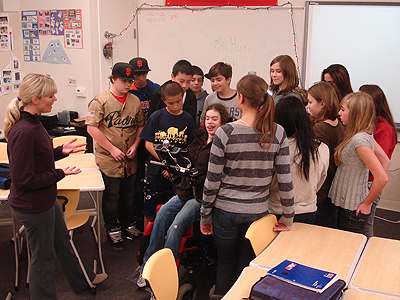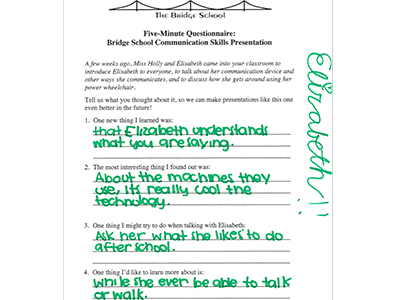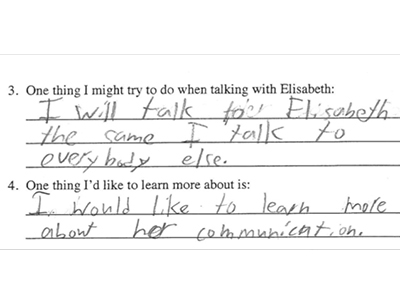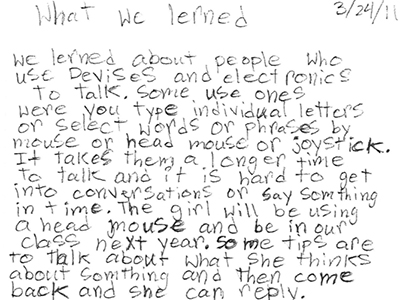As individuals learn to develop and increase self-awareness, they increase their knowledge of how, when, where and why to use AAC tools and strategies to support communication. Students recognize that what is unique about their communication style is something important to share with others. With an increased understanding of their own AAC tools and communication strategies, comes an increased responsibility for students to talk about how they talk, in order to:
- Break the ice with peers
- Build awareness in others about their unique communication style
- Demonstrate how they use popular technologies as well as Assistive Technologies
- Emphasize similarities with others versus differences

As students with complex communication needs grow more self-determined, they increasingly take responsibility for teaching others in their classrooms and in their communities about AAC and AT. This type of a presentation could be used for a variety of purposes, including as:
- A launching pad for introducing themselves
- A tool for making and developing relationships
- A way to broaden their social networks
- A starting place to train peer communication partners
The Talking with Technology Presentation aims to support middle and high schoolers to educate, engage and enlist others as they take on more and more responsibility for teaching people in their classrooms and in their communities about AAC and AT.
Special thanks and acknowledgement to Kelly Rinehart for her work on the initial development of the Communication Awareness program at The Bridge School.
Educate: Build awareness in the community about people with communication disabilities. Highlight use of popular technologies as well as Assistive Technologies.
The first goal of Talking with Technology is to educate others about individuals with communication disabilities. You can do this at the start of a new class, a new club, a new school year or anytime that works for the student and the class.
The general format is:
- The student leads the talk, taking on whatever amount of the actual speaking part they feel comfortable with.
The talk contains:
- Short movie clips of student using their high-tech and low-tech AAC systems (over the shoulder video clips work really well here)
- Description of the student’s selection techniques – such as eye gaze or head mousing to clarify and teach others how the student accesses language
- Information about student interests – what they like, what they don’t like, fun facts about them
Our middle school student worked collaboratively with her team to design a spoken audio and visual presentation, which she delivered 5 different times.
Engage: Provide opportunities for hands-on learning by trying out AAC systems and asking questions about how things work.
The second goal for the Talking with Technology presentation is to engage the students by:
- Encouraging active participation
- Creating opportunities for hands-on learning with AAC systems
- Providing a Question & Answer period – this is highly valuable because it marks a time where questions are encouraged and students can get clear answers and accurate information
Participants learn how to join in a conversation with someone who uses AAC by learning a few strategies they can actually use.
In this next clip, you’ll see a brave volunteer try yes/no cards. He’s holding her “yes” card in his left hand and her “no” card in his right hand.
You will see them trying to figure things out at first and you’ll notice him peeking at the screen on her device to see what she’s doing. He’ll ask her two questions, “do you like to eat?”, “do you like any sports?”
Notice that she said, “yes”, she likes to eat (she’s actually quite a foodie) and ‘no’, she doesn’t like sports.
Enlist: Identify people interested in learning more.
The last goal of the Talking with Technology presentation is to identify people who want to learn more.
At the end of the presentation, we ask the student participants to complete a Five-Minute Questionnaire by responding to the following statements:
- One new thing I learned was…
- The most interesting thing I found out was…
- One thing I might try to do when talking with (student) is…
- One thing I’d like to learn more about is…

Here is what some of Elisabeth’s 8th grade classmates had to say.

Here is another response from Elisabeth’s classmate.

Here is feedback from a talk Elisabeth gave to a group of high schoolers when she was finishing up her 8th grade year.

